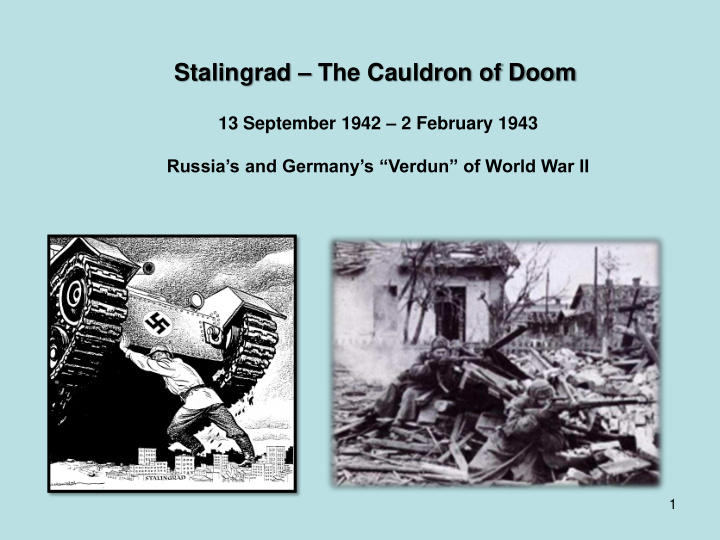



Stalingrad – The Cauldron of Doom 13 September 1942 – 2 February 1943 Russia’s and Germany’s “Verdun” of World War II 1
Germany’s Furthest Advance into Russia in WWII 2
3
German Army Front • Spring / Summer Offensives • Advances S.E. in Effort to Seize Key Oil Producing Regions of the Caucasus Mountains. German 6 th Army • General von Paulus • 300,000 Germans Soldiers • Lacking Significant Armor • Germany will be at the Greatest Extent of their Supply Line • Advance on Stalingrad 4
City of Stalingrad “Modern” Factor City Showpiece of Russian Industry Volga River Pre-War Population of 850,000 5
Heaviest fighting in the city will take place at the Tractor Factory . 6
Three Dominant Factories Dzerzhinsky Tractor Factory Barrikady Ordnance Factory Red October Steel Plant Red October Plant 7
The Fighting Becomes Static – Does Not Change 8
Intensity and Savagery of the Fighting Fighting is House to House In the Sewers In the Factories Becomes a Battle of Attrition • Hitler Wants to Capture the City = Stalin’s name • Stalin wants to Save City = His name! Nikita Khrushchev Serves as a Political Commissar at Stalingrad! Becomes a Battle of Supply Russians Reinforcing across the Volga River Germans Bring in by Air – Importance of Airfields! 9
10
Soviets Launch Operation “Uranus” Germans Surrounded!! 11
Becomes a Battle of Logistics Encirclement Cuts Off Germans Creates the Kessel (“Cauldron”) Soviet Supply Line Improves Moves Across the Volga Men / Material / Food German Supply Line Shrinks Depends on Airfields Requires 800 Tons Supplies Daily Luftwaffe only delivers 120 Tons Daily German Soldiers Begin to die of Malnutrition – Starvation! 12
The End! 13
2 February 1943 – The End Approximately 300,000 Germans Entered 160,000+ Dead (Axis = 500,000+) 130,000 Captured (91,000 at end) 1955 – Only 6,000 Returned to Germany 22 Generals including von Paulus Most catastrophic defeat in German history! Campaign Cost Axis (Romania, Italy, Spain, Hungary) between 500,000 – 850,000 casualties. 14
Stalingrad Becomes for “The Russia a Symbol of Motherland Sacrifice Calls” 279’ Tall / Weight = 7,900 Tons of Concrete 15
Russia’s Price for Victory at Stalingrad 1.1 Million Casualties • 485,751 Dead Pre-War Stalingrad = 850,000 Residents (workers) Post-Battle Stalingrad = 9,800 Civilians left in city Start 14 September 1942 – End 2 February 1943 141 Days of Continuous Combat German War Dead 3,445 Russians Died Each Day! 40,000 in Mass Grave! 14,500 Russian Soldiers (= one division) Executed by Russian Military Police for Cowardice or Desertion! 16
Russia’s Price for Victory at Stalingrad (‘Cont) From 19 November 1942 (Start of Uranus) through 2 February 1943 • 154,885 Dead • 330,892 Wounded Barmaley Fountain 6 Children & a Crocodile Enters Russian The Hero of Stalingrad History as their Soviet General Vasily Chuikov Greatest Victory! • Gains Fame as the Defender of Stalingrad 17
Recommend
More recommend